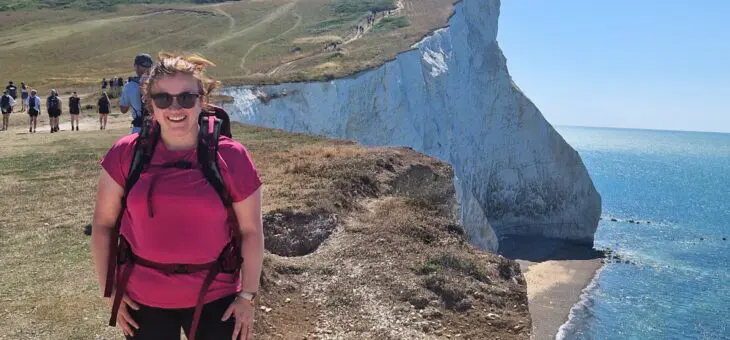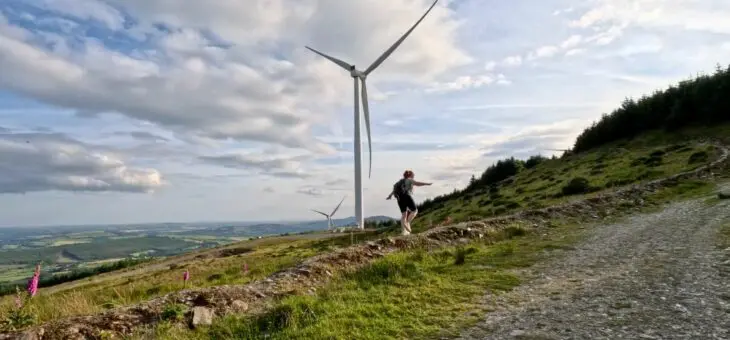Have a read of Mike Jones’s excellent piece about his Kilimanjaro expedition in January 2014.
Once upon a time, I was a wannabe mountaineer, with a poster of Everest on my wall and an unquenchable thirst for mountain adventures, heading off to the hills around Ireland when I had free time from school. Once I turned 18 venturing off to the snowy hills of Scotland and the lofty peaks of the French and Swiss alps. In recent years, however, I have been more inclined to mess around in boats with my adventures involving me, sitting on my arse for long periods travelling very slowly over vast distances. Over the winter of 2013 my wife, Andree, cooked up the idea that we should take an adventure together, a week of van chaud and powder in a ski resort wasn’t going to cut it, she wanted to try something new and more exotic. So after a brief search Kilimanjaro popped up, neither of us shot the idea down and before we knew it our arms ached from travel vaccines and we were committed (not to an institution as many of you may think!).
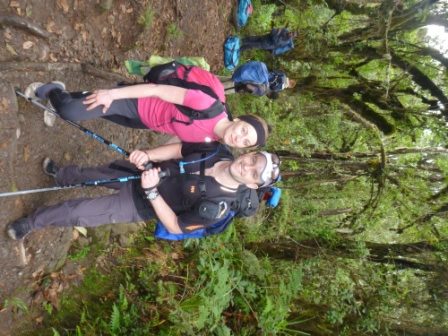
Being the total map nerd that I am, I began to gather info about how far we would have to walk and, climb each day and with only 35km to cover over five days of walking only seven kms a day on average it did not sound too difficult! The only problem is we also had to climb over 4.5km (nearly three miles in old money) from our drop off point at the entrance to the national park. So maybe it was going to be a little more difficult, oh and for the last 1,000m of climbing the air only has about half of the life giving oxygen we are accustomed to at sea level.
We also signed up with only six weeks to our departure date which did not leave us, or maybe me, time to get fit. So we spent most of our free time in December and early January clocking up miles in our local hills and after a final long walk on Irelands highest peak Carrantuohill, we were set.
Possibly just as daunting as the fact that we were off to the top of Africa was the fact that we were also about to spend a week in the wilderness with 21 complete strangers, fortunately, it transpired they were not all strange and we were all of a similar adventure loving mindset.
As a used to be wannabe mountaineer I was hoping not to look too much like a tourist but that soon went out the window as I stood in for photos at the park gate and to be fair the colour of my skin didn’t exactly make me look like a local. I quickly committed to the fact that expeditions on Kili are a big business and I was just another punter, one of 1,000’s each year who makes the pilgrimage in hopes of watching the sunrise over Africa from her highest vantage point.
 No sooner had I committed to being a tourist on my “Holidays” out for a hike in the jungle than we were all made feel right at home, the all too familiar tap, tap, drop, yip it was, rain, just like home. Only 100m walked and it was time for full rain gear and a soggy hike through the lush green jungle which surrounds the base of the mountain.
No sooner had I committed to being a tourist on my “Holidays” out for a hike in the jungle than we were all made feel right at home, the all too familiar tap, tap, drop, yip it was, rain, just like home. Only 100m walked and it was time for full rain gear and a soggy hike through the lush green jungle which surrounds the base of the mountain.
By the time we reached our first camp after five hours of walking we had begun to dry off and our porters who had carried most of our equipment had already established our home for night one. A scatter of yellow and grey expedition tents would be our double or twin hotel rooms for the next week, a long green ridge tent would serve as the dining room and two tall green tents resembling canvas phone boxes, without the windows, would house the most important facility, the lavatory, one for the ladies and the other for the gents.
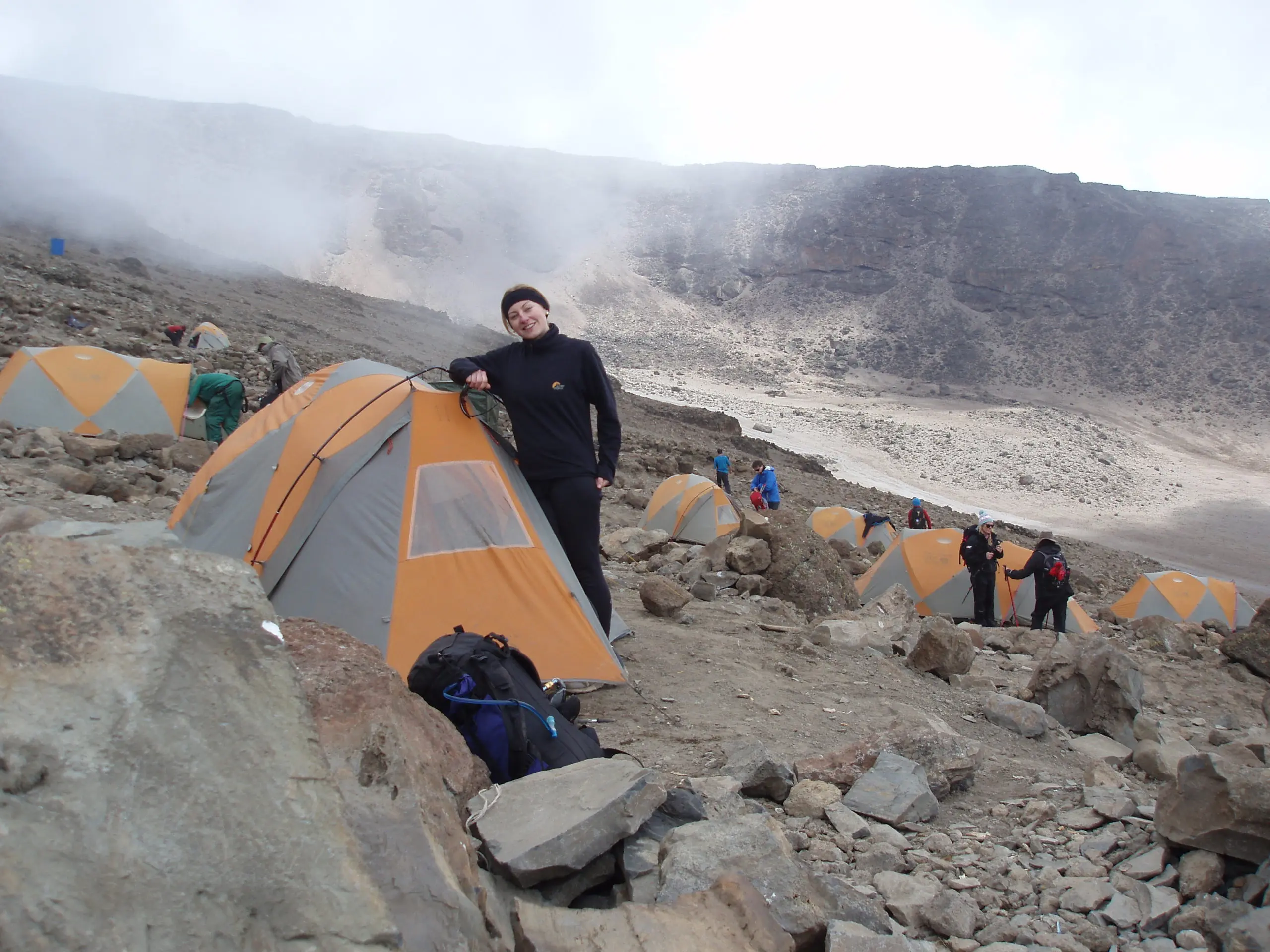
On almost all of my previous expeditions, I have been self-sufficient carrying all my own kit, pitching my own tent, cooking my own meals and finding my own way. This type of expedition, however, is different. On Kili, as with many other treks, local porters and guides are utilised. The porters, most of whom are local boys and men from the Chaga and Maasai tribes aged from 14 up are hired to carry a load of up to 25kg up the mountain each day. Loads can comprise of anything from tent poles to gas bottles, to our luggage and of course the aforementioned portaloos. They also serve as cooks, waiters, dishwashers, tent pitchers and toilet cleaners. They are immensely fit and dedicated; they climb with minimal kit themselves and with basic food and water rations all to make a half decent living. It is also worth noting that there are a few female porters, they tend to be from the Chaga tribe which expects women to work equally with men, so there is no special allowance, they must also carry a 25kg load. Our expedition team consisted of 23 and to support us and carry our kit up the mountain we had over 50 porters, on average there are 2.5 porters for each person attempting to climb the mountain.

In addition to the porters and to make sure we stayed on track we also had a team of nine local guides, this was in addition to our two very experienced and competent Irish guides. The job of the guides is to look after the clients, keep us entertained and to do whatever they can to get each person safely to the summit and back down again. Each of the guides had previously served their time as a porter, learning the mountain, gaining fitness and earning the trust of a company which would then pay for them to train as a guide. A rigorous six month training course which teaches them all there is to know about the mountain and how to safely lead people to the summit culminates in a demanding four day assessment which includes a pass-fail time trial from high camp to the summit, a test of fitness and endurance. I know one lady in our group who also wanted to try out this challenge, my wife the guide in a former life.
After a couple of days of “pole, pole” along the mountain paths I began to settle into a routine and as we strolled through the day, a familiar weather pattern of clear cold mornings followed by clouds and rain around noon and the clear evening helped to punctuate the day. Regular toilet breaks and snack stops also gave an opportunity to take in the views and surroundings. As we moved from the jungle the mountain-scape changed in distinct layers with vegetation becoming sparse as we gained in altitude leaving rise to a lunar barren mountainside.
The mountain is a dormant volcano which last erupted over 40 million years ago and evidence of familiar limestone was evidence that this vast mountain once sat below an ocean, a truly crazy fact which is difficult to comprehend when you are over 4km above what is now sea level.
Through the middle days of the week on the mountain we settled into a routine which began with a friendly wake up from room service and a hot drink at 0630 each morning. These few days allowed our bodies to acclimatise to the altitude ensuring our heart and lungs became attuned to the additional demands which would be placed on them as the air thinned and the oxygen content dropped. It also gave us the opportunity to get to know each other and as we meandered along the stony paths there was plenty of time to chat, tell jokes and share stories with our guides and fellow trekkers.
On the fifth day in the early afternoon we reached a height of 4,650m, this was the height of our final camp. Our tents were each pitched on ledges carved and flattened from a jagged rocky hillside. This would be the staging point for our attempt on the summit, the climax of our trip was merely hours away and there was a noticeable air of anticipation amongst the group.
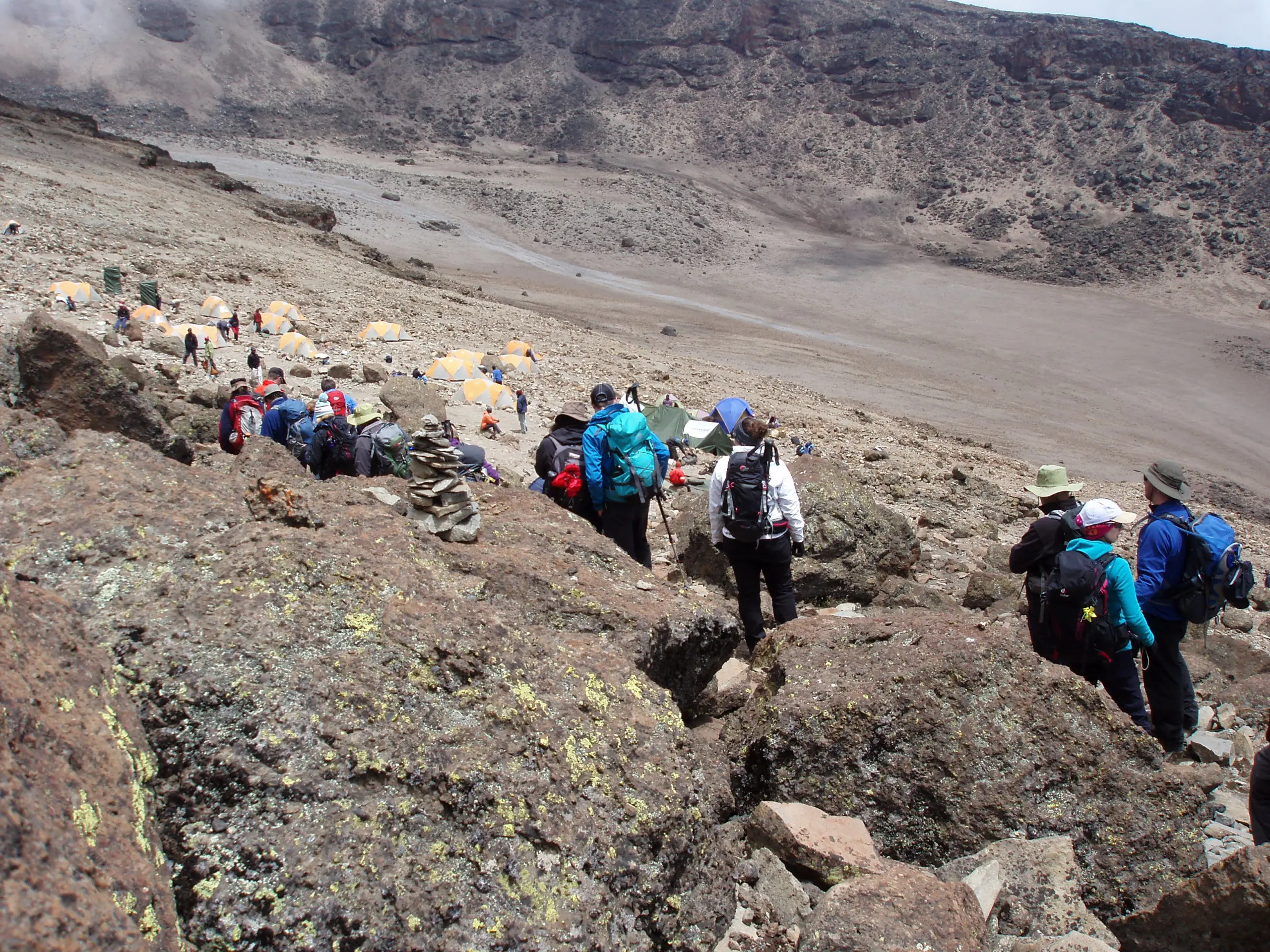
An early dinner followed by a couple of hours of shut eye before an 11 pm wake up call, yes 11 pm! The early or rather late rising hour was part of the plan to give us maximum time and opportunity to summit and descend during daylight. At 11:30 pm we lined up behind our lead guide Babaloo each wrapped like onions in a combination of base layers, fleeces, down jackets and woolly hats the mood was good. We each knew a serious challenge lay ahead and as we slowly marched out of camp our focus moved to the pair of heels in front and the dim bubble of head torch light shining at our feet, this would show the way for the next seven hours.
As we moved across the gentle lower slopes we chatted in small groups keeping no more than 3 feet from the person in front to ensure we kept to the path being forged in the darkness by Babaloo. At over 6’ his tall dark figure clad in a black down jacket was easy to lose sight of, especially as he had no torch.
Soon the path began to narrow and steepen as it zig-zagged through scree strewn slopes. Slow and steady was the motto with breaks every 40minutes to take on food or water. Just over halfway I began to flag, my energy levels were low, my head began to ache and I began to stumble and lose my balance as I tried to focus on the path illuminated by my torch. I needed fuel and water, at the next break I forced down an energy gel, my first at altitude. It certainly helped with my blood sugar and within minutes my spirits were lifted, it also began to play havoc with my stomach, but that is a story for another day.
Refuelled I began to enjoy the experience once again and took a moment to reflect on how surreal it was for me marching amongst a line of head-torched paddies on the highest free-standing mountain in the world while our guides sang local songs to raise our spirits and motivate us. A moment very hard to describe but one I will not forget in a hurry and for me a highlight of the trip.
Six hours is a long time to walk and when you have only covered about five kilometres it is also a very slow walk but the final steps to Stella Point with day breaking over our shoulders made it all fade away in an instant. At over 5,600m this is not quite the summit but we had broken the back of it, we had the hard part behind us and now it was a gently sloping 40minute stroll to the top of Africa. We regrouped here and clinked plastic cups of sugary tea to celebrate our nights’ work and joined in more song with our guides and Canadian Medical Assistant, Vince, who had been busy learning some Swahili verses.
Powered by the tea, the rising sunshine and adrenaline the last section was pure bliss and painless. The rocky path which was carved through the blanket of snow led us along the rim of the crater, slowly gaining height toward “Uhuru” the highest point of the mountain which translates to “Freedom”. To our right we could look into the snow-filled crater bowl of this now dormant volcano and to our left, almost ready to slide off the side of the mountain, a massive Glacier, with ice walls 30m high being majestically lit by the rising sun it was difficult to keep focused on the path.
This 40 minutes went by far quicker than any of those previous and I arrived on the summit along with the first of our group and took a moment to just soak it all in. Goal achieved, smiles all round, and even some tear-filled eyes. This had been no walk in the park and the sense of achievement was palpable.
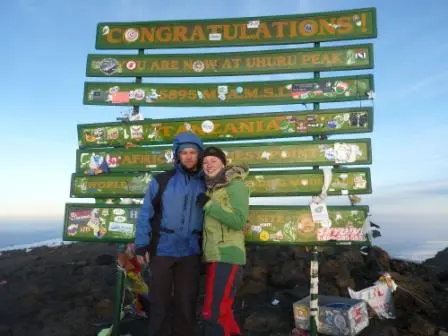
We took turns to get our photograph taken with the summit sign, then one big group photo. As our bodies began to chill due to the icy temperatures it was then time to get moving again, it was all downhill from here. We skipped freely down the path, passing and encouraging those still fighting gravity as we now had it to our advantage and it felt great. In no time at all, we arrived back to Stella Point and after regrouping the decision was taken to split the group into two, a fast and slow group. Andree is a pretty good descender so I joined her and about six others in the faster group and off we went, over the lip and down the srcee.
I was last in our group and was quickly engulfed in a cloud of dust, the deep loose scree was moving under our feet and the crowd in front began to create a fog which was rising up and choking me. In order to escape, I decided to pick up the pace and using my poles began to pass some of my group like a skier turning and cutting a zigzag path aggressively into the slope. I grew braver and braver venturing off the mainline, in the zone and in total control, until slip, slide… both my feet went and I broke my fall with my elbows, grazed and feeling like I had just been told off by the mountain I slowed my pace and moved safely back to camp with my group.
Seven hours up and about two and a half down, that is a pretty clear testament to how tough a climb it is. A welcome cool drink at camp and a few hours’ sleep was well earned at that stage of the day; it was still only 09:30 am. Later that day we descended further and moved to a lower camp to spend our last night on the mountain at Millennium camp. Only a half-day of walking now stood between us and a hot shower and I slept with a smile on my face knowing that it was mission accomplished.
On the final morning, we bid fair well to our porters as they packed up camp and raced down the mountain, keen to get back to their families after a tough week in the office. Our pace was a little slower than theirs and it was a good chance to review the week and talk about what the future held, more adventure, safari, cold beer and of course a hot shower.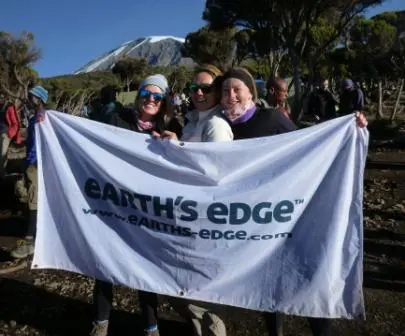
Thanks to all the team for a great adventure, if you are thinking about Kilimanjaro as your next adventure I could not recommend Earth’s Edge highly enough, they also do cool trips to other parts of the world and I look forward to joining them again in the future for another awesome adventure.

